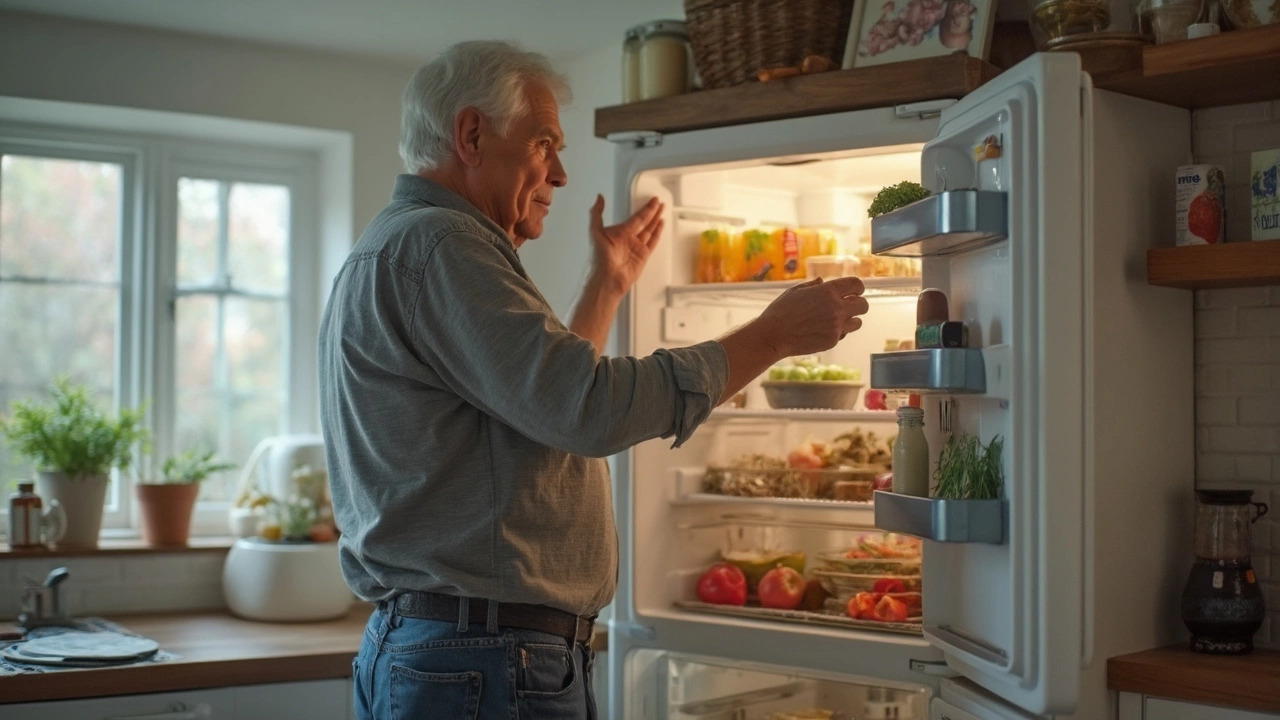Ever try to stash a leftover pizza box in a side by side fridge? It’s almost like a game—except you rarely win. These fridges look slick and modern, but when it comes to practical use, they can surprise you in ways you may not love. Their split doors mean each compartment is tall and narrow, making it tricky to pile in large or oddly shaped items. You’ll need to get creative, like stacking things sideways or squishing jars together, just to shut the door.
People with small kitchens might like the way side by side fridges need less clearance for each door. But is that enough to make up for squeezing in groceries or hunting for that jar of pickles at the way back? If you love to cook, meal prep, or have a big family, the space setup could make you shake your head later. Let’s dig into the real downsides so you don’t fall for the shiny look alone.
- Awkward Storage and Shelf Space
- Trouble Fitting Big Items
- Energy Efficiency and Costs
- Organization Headaches
- Kitchen Fit and Accessibility
Awkward Storage and Shelf Space
If you’re thinking a side by side refrigerator is going to solve all your kitchen storage problems, think again. The split down the middle means each section is pretty slim compared to top-freezer or French-door models. You might find yourself trying to Tetris a huge casserole dish inside, only to realize there’s just no way it’ll fit unless you remove half the shelves first.
One of the most common complaints is those narrow shelves. Standard pizza boxes, party platters, or even some watermelons just won’t make it—at least not without a struggle. You get long, vertical space for bottles and tall drinks, but horizontal space is where this design feels cramped. Some shelves can be adjusted, but the overall width just doesn’t change, so big stuff is always a pain.
Check out this quick comparison to see how shelf widths measure up across different types of refrigerators:
| Fridge Type | Average Shelf Width (inches) |
|---|---|
| Side by Side | 12-16 |
| French Door | 24-36 |
| Top/Bottom Freezer | 18-28 |
Notice how much smaller the shelves are in side by side fridges? Even the freezer section can get tricky when you want to store things flat. If you buy frozen pizzas, expect battles every grocery day.
- Plan your shopping around what fits, not just what you need.
- Storing leftovers means smaller containers, stacked smartly.
- Odd-shaped produce or large party trays can cramp up the shelves fast.
Think about how you organize groceries at home. If you like spreading things out, or having everything easy to grab, the skinny shelf setup can feel limiting pretty quickly. My own cat, Whiskers, could probably fit on a shelf, but not much else as wide as him! Just something to consider if you don’t want food jammed together or hidden behind stacks of stuff.
Energy Efficiency and Costs
Side by side refrigerators aren’t usually the champs when it comes to saving energy, and that can hit your wallet over time. The design—with the freezer on one side and the fridge on the other—means both doors are tall, narrow, and get opened often. Every time you open the door to make a midnight raid for cheese sticks, cold air escapes fast and the fridge works harder to keep up.
Older models are known to gobble up more electricity compared to newer fridges with top or bottom freezers. Even among recent models, side by sides often land on the less-efficient end of the scale. To back it up, the U.S. Department of Energy rates refrigerator styles by average use per year, and side by sides usually draw more power than bottom-freezer types. Here’s a quick comparison to make things clear:
| Refrigerator Style | Average Yearly Energy Use (kWh) | Estimated Annual Cost |
|---|---|---|
| Side by Side | 630 | $80 |
| Top Freezer | 500 | $65 |
| Bottom Freezer | 560 | $72 |
Multiply that difference by a few years, and your side by side could mean noticeably higher utility bills. Not to mention, bigger models with fancy features like ice and water dispensers take even more juice. Those dispensers look neat, but they add to the energy tab—sometimes up to 15% more usage compared to models without them.
- Look for an Energy Star label if you go for a side by side. It’s not a magic fix, but it helps.
- If you’re budget-conscious, check the energy use sticker in the store. Don’t just get distracted by shiny handles or digital screens.
The bottom line: that side by side refrigerator could cost you every single month, long after the delivery crew hauls it into your kitchen.

Organization Headaches
The number one complaint I hear about side by side refrigerator models? Organizing stuff somehow ends up taking more time than it should. The tall, skinny compartments sound fine at first, but reality kicks in when you’re trying to fit your weekly grocery haul. The shelves are usually smaller front to back, so things get lost quickly—especially leftovers and small jars. It's not uncommon to find forgotten food way in the back, only after it’s gone bad.
One annoying thing is how you have to stack everything, especially in the freezer section. Those skinny shelves are tricky with frozen pizzas, chicken boxes, or even bags of veggies. You either end up squeezing the packaging or playing Tetris every time you put something away.
Also, fixed shelves and bins limit how you arrange things. Some side by sides let you move shelves, but you won’t get much flexibility to customize space. Here’s a quick look at some real-world feedback about how people organize these fridges:
| Issue | % of Owners Reporting |
|---|---|
| Hard to find items (fridge side) | 38% |
| Freezer too cramped | 47% |
| Not enough door storage | 30% |
If you like to batch cook or store big containers, you’ll notice the awkward layout fast. Stacking stuff in the freezer can also block air flow, so your food doesn’t always freeze evenly. Smaller spaces between shelves mean you need to bend down or move things constantly when you want that one item hiding in the back. Some folks handle this by labeling bins or using clear containers, but that means spending more money and time organizing.
One simple tip: group similar foods together using small baskets (think cheese in one, snack packs in another). But honestly, even with nifty organizing hacks, you might still end up annoyed when everything you need is behind something else. If you’ve got kids, expect them to cram stuff back anywhere there’s an inch of space, making finding things even tougher next time.
Kitchen Fit and Accessibility
Side by side refrigerators get a lot of credit for their narrow doors. If you’ve got a galley kitchen or islands that crowd your space, those doors can really help. Instead of needing a wide swing like you do with French door or single door models, you only need a couple feet of clearance per side. Plenty of people think this sounds perfect—until they start actually loading groceries and using the fridge every single day.
There’s a catch. Even though the doors take up less room when open, the internal shelves run tall and skinny from top to bottom. This design can make it tough to see what’s stuffed in the back, and it’s even harder to reach things on the lower shelves—especially for kids or anyone who doesn’t love bending and digging. If you’ve ever watched someone stand on their tiptoes just to snag a yogurt, you get what I mean.
Here’s a quick look at common sizing so you can see how side by side models compare with other fridge types:
| Fridge Type | Recommended Minimum Door Clearance | Typical Width (inches) |
|---|---|---|
| Side by Side | 18-24 inches per door | 32-39 |
| French Door | 33-36 inches per door | 33-36 |
| Top Freezer | 30-34 inches per door | 28-33 |
If you’re someone who uses a wheelchair or has limited mobility, these tall shelves can be even more of a pain. The freezer side is even skinnier, making it a challenge to pull out bigger frozen foods. And if your kitchen isn’t level (hello, old houses), those doors might not close right on their own either.
Some tips if you’re still eyeing a side by side: measure all your entryways and cabinet clearances before you buy, and think about where the fridge will sit compared to your work areas. If accessibility is a top concern, try to check out fridges in person so you’re not stuck wrestling with shelves or hunting down a lost can of soda behind a stack of leftovers. Sometimes Whiskers—the cat—gets lost in ours. Joking (mostly). Just goes to show how deep and narrow those shelves really are!
- Measure both fridge and kitchen multiple times.
- Practice opening doors in-store at max extension to check fit.
- Consider adding pull-out baskets for easier reach.
So, while side by side models can save space around their side by side refrigerator doors, they may not offer the most user-friendly storage or access, especially in busy kitchens or for those who need easy reach.
